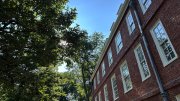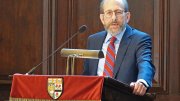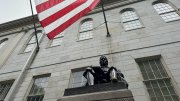Harvard announced this morning that it was overhauling disciplinary procedures involving violations of the University-wide Statement on Rights and Responsibilities—suggesting a recognition that the ways in which discipline was administered by each separate school after the pro-Palestinian protest encampment from April 24 to May 14 need reform.
A statement disseminated by University leaders including interim president Alan M. Garber, interim provost John F. Manning, and the school deans observes that for Harvard to live up to the standards and commitments in the Statement on Rights and Responsibilities (the centrality of which Garber underscored with the deans on January 19, less than three weeks after he assumed the presidency), “the processes by which we implement them must be fair, effective, and even-handed. In recent years, this goal has been challenged in a growing number of disciplinary cases involving students from different schools who are involved in the same event or behavior but may be subject to quite different investigative and fact-finding processes. Fully acknowledging that, at Harvard, each school is responsible for determining discipline for its own students, the facts informing discipline should not vary depending on what school a particular student attends.”
A Very Unsettled Process
That anodyne language melds several important concerns. After the encampment disbanded May 14 and Garber asked the schools to, in effect, undo the “involuntary leave” he had imposed on protestors May 10, he also directed the schools to pursue their independent disciplinary processes expeditiously. The College’s Administrative Board apparently did so promptly, but as is customary made no announcement of its decisions: citing privacy laws, Harvard declines all comment on disciplinary cases, with the result that communication is by default devolved to those affected—in this case, the protestors, who are participants and partisans. On May 17, student protestors angrily reported that numerous undergraduates had been suspended or placed on probation for their participation in the encampment, including 13 who would therefore not receive their diplomas May 23. (For a review of the ensuing Faculty of Arts and Sciences [FAS] vote attempting to override this decision on May 20, and the Corporation’s decision May 22 that the students were not in “good standing” and so could not graduate, and the ensuing protest speeches and walkout from Commencement, see the July-August issue’s “Locked In,” page 17, and “Commencement 372 7/8,” page 10.) Further complicating matters:
•Discipline of Graduate School of Arts and Sciences protestors (also within FAS, but under a separate Ad Board) was confined to milder probations, according to the protestors’ statement of June 25. (Because the University and schools will not comment in any way on the nature of the violations being punished, the punishments themselves, varying outcomes of disciplinary cases, or aggravating or mitigating circumstances—such as repeat offenses—it is impossible for outsiders to analyze the severity of alleged violations of the University standards or whether they are being adjudicated equitably across schools.)
•According to participants or close observers of the protests who refused to be named, protestors from the professional schools who were disciplined received milder sanctions (admonitions or warnings). Again, in the absence of information from the University, it is impossible to verify those claims, or to judge whether similar infractions resulted in variable punishments.
•Finally, on July 9, the protestors’ social media account reported that the College Ad Board’s suspensions had been reduced to the lesser punishment of probation, and that the terms of probations imposed on other undergraduates had been reduced. This result apparently stems from the students’ appeal to FAS’s Faculty Council, provided for in disciplinary procedures for those required to withdraw or placed on probation for more than one term. The grounds for Faculty Council action are findings that the Ad Board committed a procedural error or imposed punishments disproportionate to those it has imposed in other cases. Absent further information from the University or College, it is impossible to say what matters governed this outcome, but the reduction of penalties suggests that the latter factor may have been in play. It also raises anew the question of varying disciplinary outcomes cross the schools.
Thus, in the course of eight weeks, the outcome of the school-based disciplinary process meant to address violations of a University statement of fundamental values and standards produced this fallout: members of the FAS took a vote intended to undo the effect of the sanctions imposed by the College’s Ad Board; the Corporation set aside the effect of that vote—heightening disagreements between some significant segment of the faculty and the governing boards; questions arose about the possible variability of differing schools’ punishments—perhaps for similar or identical violations subject to being disciplined; and, finally, the College disciplinary appeals process apparently resulted in significant changes in the Ad Board’s decisions—raising further questions about the severity of punishments within that single faculty and school.
Beyond the obvious confusion and doubt this sows within the community, Harvard faces significant scrutiny from critics of its campus climate during the tumultuous past academic year. U. S. House of Representatives committees continue to investigate and critique University processes and procedures for dealing with incidents of antisemitism (and other kinds of bias). And the Harvard Jewish Alumni Alliance has demanded equal application of disciplinary processes—a concern echoed in different language, from a different perspective, by the University’s own task force on combating antisemitism in its recent preliminary report.
An Historical Solution?
These problems would seem to call for some consistent University-level way of investigating complaints about possible violations of the Statement on Rights and Responsibilities. Today’s message offers this path forward:
The University Committee on Rights and Responsibilities (UCRR) offers a solution to this problem. Established in 1970 and populated each year with faculty and students designated by each school, the UCRR was designed to coordinate fact-finding processes involving multiple schools while leaving the final disciplinary decisions to the schools themselves. Until now, however, effective procedures for implementing this function have not been formalized.
To overcome the implementation problem, the president and provost “last fall,” according to the message, convened a working group to propose a set of procedures for fact-finding for such cases. Garber has adopted the recommended process for a two-year interim period—decisions endorsed by the Corporation, according to the message—and the new procedures are disseminated alongside the leaders’ communication today.
The procedures call for cases involving possible violations of the University Statement “involving students from two or more faculties or cases alleging that students from one faculty have disrupted the performance of normal duties and activities within another Faculty” to be brought to the president “if an affected school or affected University-wide unit so requests,” and for the president to initiate an investigation via the University Committee on Rights and Responsibilities. It then details fact-finding procedures and deadlines, what rights the person or persons being investigated have, how evidence is to be collected and reported, interim findings, rights of response and appeal, and—for findings of a violation—forwarding of the record “to the disciplinary body of the faculties in which the respondent(s) are enrolled for determination of an appropriate disciplinary response.”
The precedent to which the University leaders’ message refers ultimately stems from the FAS Statement of Rights and Responsibilities first adopted in June 1969 (the precursor to the University statement now in effect, as amended), after the occupation of University Hall and the ensuing turmoil following police removal of the student protestors that April, and FAS’s Committee on Rights and Responsibilities (CRR), enacted September 30, 1969, as the specialized disciplinary body to hear complaints.
That faculty-student body dealt with repeated, serious violations: seizing buildings, blocking University officers’ personal movement and access to their offices, disrupting an Overseers’ visiting committee meeting, shouting down speakers at public forums, and more. The CRR established detailed procedures suited to its scope of responsibility and published detailed reports on its findings and disciplinary rulings (protecting students’ anonymity) for each case it considered. Those reports evolved a sort of jurisprudence by which the community could come to understand the exact violations of the Statement of Rights being evaluated, and the exact reasons for the penalties imposed: less severe for those who merely showed up at a protest, severer for those who physically impeded or harassed others, severest for those who committed such violations and who had been previously warned or punished for unacceptable behavior.
It was thus explicitly different from the Ad Board structure and processes for academic discipline—a recognition that the challenges posed by complaints about violations of the Statement of Rights differed in kind from complaints about student life or the course of study, and required a separate institutional solution.
The CRR had its limits: it applied only to FAS: the College, Radcliffe, and the GSAS; over time, in that heated era, students came to object to the process, and withdrew from membership. Their complaints were detailed in a 1986 undergraduate council report objecting to the CRR and its procedures when it was invoked in response to a student Harvard Yard protest (shades of 2024): the erection of a shanty town as part of the campaign to get the University to divest endowment investments in apartheid South Africa.
In Context
It comes as something of a surprise to learn that there is a University Committee on Rights and Responsibilities alive and functioning today. Queried about the matter, a Harvard spokesperson could only report that today’s UCRR is populated by having the leadership of each school propose the names of two faculty members and one student (for FAS, four faculty members and three students), who are then voted on by the governing boards annually; members serve until successors are chosen, and membership is not public. No information was forthcoming about whether, when, or how the UCRR has been active. A passage in today’s message—“Until now…effective procedures for implementing this function have not been formalized”—suggest that there is not much of a record to draw on, if any.
As proposed, the UCRR, under its new procedures, would at least result in uniform fact-finding in cases where violations of the University Statement are brought forth for investigation. But the procedures do not require a complaint to be brought into the UCRR fact-finding process; and decisions on discipline are referred back to the individual schools. If indeed there were problems from differing school approaches to fact-finding, interpretation of the University Statement, and decisions on discipline this past spring, as protestors have alleged, today’s reform could address some of those problems.
But they are limited in applying to inter-school matters; those involving only students from one school would not rise to the UCRR process. And discipline itself remains at the school level. There is long precedent for that, embedded in the University Statutes (its bylaws).
But precedents are not inviolable: the Corporation itself underwent significant reform in 2010 (something once considered impossible short of Commonwealth of Massachusetts legislation). And under pressure of the crises of the late 1960s and early 1970s, the Corporation voted to recognize powers associated with the CRR in the Statutes, and to embrace the University Statement.
Today’s announcement may well mark a recognition of the need to fix at least some part of Harvard’s University-level disciplinary processes and procedures as they have lately been deployed. But questions will remain in clear cases where complaints involve University matters considered fundamental to Harvard’s operation as an intellectual community devoted to research and teaching: What if only one school’s students are involved? Why continue to refer identical cases to multiple school-level disciplinary bodies whose interpretations of standards, evidence, and punishment may not be uniform? The two-year trial period for the new procedures announced today may be fruitful and sufficient to address the problems identified now. Or they may, over time, turn out to be a first step toward a more comprehensive reassessment of how to establish and uphold elemental academic standards in an era of polarization and protest even within the confines of Harvard’s green quadrangles.
Read the University leaders’ message here.
The 7 Ware Street commentary in Harvard Magazine’s forthcoming September-October issue explores these issues in further depth; look for it online on or about August 15.









